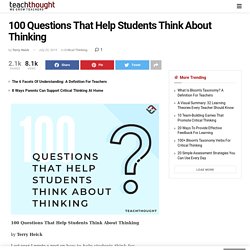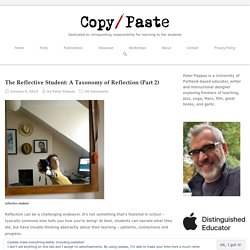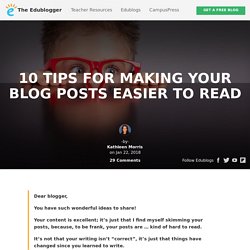

Log In ‹ Wordpress for ISS Students and Staff — WordPress. WordPress Portfolio template. Wordpress Tutorial - Google Slides. 100 Questions That Help Students Think About Thinking - 100 Questions That Help Students Think About Thinking by Terry Heick Last year I wrote a post on how to help students think for themselves.

TeachThought reader Peter Duckett wrote me a few months later with these questions below that he added in order to facilitate their use in the classroom. I’ve added some myself, and am going to continue to add more after giving you a chance to do so. In the comments below, suggest a question for one of the categories below and I’ll add them to the list. Leave your twitter username and I’ll credit you next to the question. Let them watch their predictions play out What do you think will happen? Let them form theories, and immediately test and revise those theories based on observation What do you think? Give them the right collaboration with the right “mind” at the right time With whom could you work to figure this out?
Allow them to read with choice–without guidelines or external pressure What would you like to play with? The Reflective Student: A Taxonomy of Reflection (Part 2) – Copy / Paste by Peter Pappas. Reflective student Reflection can be a challenging endeavor.

It’s not something that’s fostered in school – typically someone else tells you how you’re doing! At best, students can narrate what they did, but have trouble thinking abstractly about their learning – patterns, connections and progress. In an effort to help schools become more reflective learning environments, I’ve developed this “Taxonomy of Reflection” – modeled on Bloom’s approach. It’s posted in four installments: 1. See my Prezi tour of the Taxonomy 2. Each level of reflection is structured to parallel Bloom’s taxonomy. Taxonomy of reflection.
40ReflectionQuestions. 10 Tips For Making Your Blog Posts Easier To Read. Dear blogger,You have such wonderful ideas to share!

Your content is excellent; it’s just that I find myself skimming your posts, because, to be frank, your posts are … kind of hard to read.It’s not that your writing isn’t “correct”, it’s just that things have changed since you learned to write.In fact, it might be time to forget a lot of what you learned about writing at school.Can we chat about making your blog posts easier to read? With thanks, A hopeful reader Getting a blog post together isn’t easy, is it? You have to put all the distractions on your computer aside and focus on one task: tapping away at the keyboard and organizing all your thoughts until your post takes shape. So, of course, you want people to actually read your post. There are many personal benefits to simply writing too. So how do you encourage your visitors to not only start reading your blog post but also stick around to the end? Maybe the solution isn’t changing your words. 1) Paragraphs and Sentences 2) Fonts.
What’s the Difference Between Displaying and Documenting Learning? - Corwin Connect. Before I answer this question, I will ask another: Do you have a social media account that allows you to snap and share photos and/or videos, as well as send messages (e.g., Facebook, Instagram, Twitter)?

Thinking Strategically If you do, and you use the platform regularly, I bet a cognitive behavior has emerged over time. You think about what you want to post based on: Let me explain what I mean using my puppy as an example. Snowball started her Instagram account (snowball.the.schnauzer) when she moved into our furever home. Over time, by studying what others were posting, she began thinking often and deeply about photographs, videos, and textual messages she wanted to capture and share to increase her interactions with established and new furfriends.
Posting became an ongoing thinking and reflective process. By studying and analyzing photos and messages of others, Snowball began to reach out and connect strategically with her growing Instagram community. Displaying learning is static.